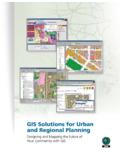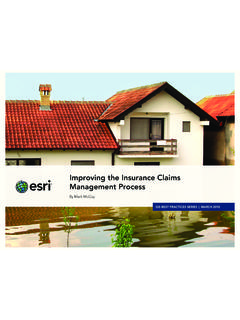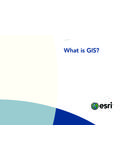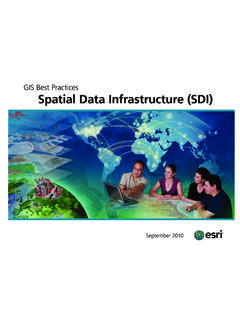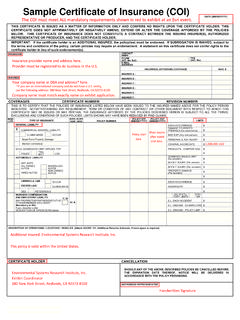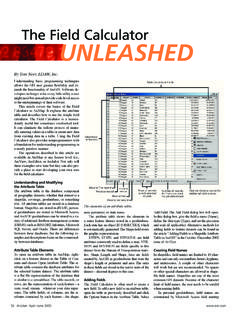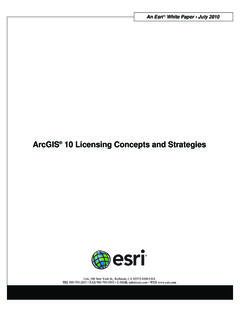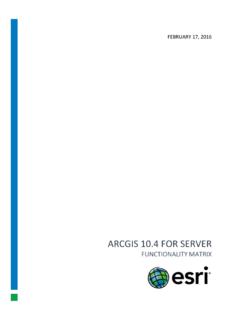Transcription of What is GIS - esri.com
1 July 2012. What is GIS? Table of Contents 5 Why Geography Matters 18 Education 6 The Power of GIS 18 Libraries and Museums 7 The Geographic Approach 19 Schools (K 12). 9 GIS in Action 19 Universities and Community Colleges 9 Geography Matters Everywhere 21 Government 10 Business 21 Federal Government 10 Banking and Financial Services 22 State Government 11 Facilities Management 22 Local Government 12 Insurance 22 Architecture, Engineering, and Construction 12 Marketing 23 Economic Development 13 Media and Press 23 Elections and Redistricting 13 Real Estate 23 Land Administration 14 Retail 24 Public Works 25 Surveying 15 Defense and Intelligence 25 Urban and Regional Planning 15 Defense and Force Health Protection 15 Geospatial Intelligence 27 Health and Human Services 16 Installations and Environment 27 Health Research 17 C4 ISR Military Operations 27 Hospital and Health Systems 28 Human Services 28 Managed Care 29 Public Health What Is GIS?
2 2. Table of Contents (continued). 30 Mapping and Charting 42 Public Safety 30 Aeronautical 42 Computer-Aided Dispatch 31 Cartographic 43 Emergency/Disaster Management 32 Nautical 43 Fire, Rescue, and EMS. 32 Spatial Data Infrastructure 44 Homeland Security 33 Topographic 45 Humanitarian Aid 46 Law Enforcement 34 Natural Resources 47 Wildland Fire Management 34 Agriculture 35 Archaeology 48 Transportation 35 Climate Change 48 Aviation 36 Conservation 49 Highways 36 Environmental Management 49 Logistics 37 Forestry 50 Railways 38 Marine and Coast 51 Ports and Maritime 39 Mining 51 Public Transit 39 Petroleum 53 Utilities and Communications 40 Sustainable Development 53 Electric 41 Water Resources 54 Gas 54 Pipeline 54 Telecommunications 55 Water/Wastewater What Is GIS?
3 3. Table of Contents (continued). 57 Geography at Work 59 Try GIS. 59 Mapping for Everyone 59 ArcGIS Online 60 ArcGIS Explorer 61 Learn More 61 What is GIS? Website 61 GIS Day 61 What Is GIS? 4. Why Geography Matters A transformation is taking place. Businesses and governments, flooding or other natural disasters? Where are power poles schools and hospitals, nonprofit organizations, and others, are located, and when did they last receive maintenance? taking advantage of it. All around the world, people are working more efficiently because of it. Information that was limited to spreadsheets and databases is being unleashed in a new, exciting way all using geography. But this isn't your elementary school's geography.
4 This approach uses geography to gain new insights and make better, more informed decisions. Consider an example. In Texas, a department store analyzing credit card receipts by ZIP Code finds that a large number of its customers drive along a particular section of the freeway to reach a mall. The store could then make smart choices about where to place its billboard ads. Linking location to information is a process that applies to many aspects of decision making in business and the community. Choosing a site, targeting a market segment, planning a distribution network, zoning a neighborhood, allocating resources, and responding to emergencies all these problems involve questions of geography. Where are current and potential Search and rescue teams use GIS to analyze incidents and help save lives.
5 Customers? In which areas do consumers with particular profiles live? Which areas of a city are most vulnerable to seasonal What Is GIS? Why Geography Matters 5. How do organizations unlock geography from the data they human activity. Often, this data is viewed on a map, which use every day to make decisions? For anyone trying to evaluate provides an advantage over using spreadsheets or databases. information, the most intuitive way to view it is on a map. Why? Because maps and spatial analysis can reveal patterns, Not just any map intelligent digital maps made possible by point out problems, and show connections that may not be geographic information system (GIS) technology. Even people apparent in tables or text.
6 Who have never used maps to analyze data are finding that maps make processing information much easier and more effective. The Power of GIS. GIS represents features on the earth buildings, cities, roads, GIS is computer software that links geographic information rivers, and states on a computer. People use GIS to visualize, (where things are) with descriptive information (what things are). question, analyze, and understand data about the world and Unlike a flat paper map, where what you see is what you get, GIS. can present many layers of different information. To use a paper map, all you do is unfold it. Spread out before you is a representation of cities and roads, mountains and rivers, railroads, and political boundaries.
7 The cities are represented by little dots or circles, the roads by black lines, the mountain peaks by tiny triangles, and the lakes by small blue areas similar to the real lakes. A GIS-based map is not much more difficult to use than a paper map. As on the paper map, there are dots or points that represent features on the map such as cities, lines that represent features such as roads, and small areas that represent features such as lakes. GIS links imagery and data to utility, landscape, and maintenance All this information where the point is located, how long the schedules for complete rights-of-way management. road is, and even how many square miles a lake occupies is What Is GIS? Why Geography Matters 6.
8 Stored as layers in digital format as a pattern of ones and zeros in These themes can be laid on top of one another, creating a stack a computer. of information about the same geographic area. Each layer can be turned off and on, as if you were peeling a layer off the stack or placing it back on. You control the amount of information about an area that you want to see, at any time, on any specific map. The Geographic Approach Maps are a proven method of communicating geographic knowledge. When a decision needs to be made, GIS helps us gather place-based information and organize it on a digital map. We then use GIS to evaluate the decision. Once we fully understand the geographic consequences of our decision, we can then act in an informed, responsible manner.
9 3D analysis enables planners to model the impacts of proposed changes. This geographic approach to problem solving helps us answer a Think of this geographic data as layers of information within the wide variety of important questions related to geography, such computer screen. as these: Each layer represents a particular theme or feature of the map. Where are my current and potential customers? One theme could be made up of all the roads in an area. Another theme could represent all the lakes in the same area. Yet another Which areas of my town are most vulnerable to natural could represent all the cities. disasters? Where should we locate a new elementary school? What Is GIS? Why Geography Matters 7.
10 GIS helps answer such questions by combining data from Better decision making governments and other sources in a custom map. Improved communication Better geographic information record keeping Geographic management Remote-sensing satellites and earthbound sensors are providing us with vast amounts of data about our planet. With the availability of new, easy-to-use GIS tools to display and analyze this data, now everyone can be an explorer. This has far-reaching benefits to both society and the environment, ushering in a new era of understanding our world. By comparing historical disaster data with vulnerable populations, GIS is used for disaster planning. The geographic approach benefits organizations of all sizes and in almost every industry, and there is a growing interest in and awareness of its economic and strategic value.
